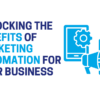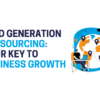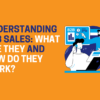Lead Generation: The Guide to Generating Sales
Lead generation is the process of generating interest in your product or service in order to boost your sales and brand awareness.
In B2B (business-to-business) marketing, leads are typically generated via telemarketing, and this can be complemented with digital marketing. There’s a lot more to it than just picking up the phone, which is just one of the reasons you might want to consider outsourcing your lead generation.
Anyway, now that we’ve shamelessly plugged our own services, we’ve put together a guide to everything you need to know about B2B lead generation.

What Makes Lead Generation So Important?
If you want to grow your business (and at the risk of overstepping, we’re guessing you do), lead generation is the way to go about it. With high quality data and effective messaging, you’ll be well on your way to optimising your sales funnel. Interest will become leads, and leads will become conversions.
Is it always that easy? Certainly not. And lead generation can often feel like an uphill crawl. But patience pays off, especially when you’re combining your B2B telemarketing with digital marketing.
No time for all that patience? Keep reading!

Why You Should Outsource Your Lead Generation
Companies often underestimate the benefits of outsourcing their B2B lead generation. This is likely down to a whole host of misconceptions people tend to have when it comes to lead generation, which we’ll get to very shortly.
In reality, there are a wealth of benefits to outsourcing your B2B telemarketing to specialists. Let’s look at just a handful of those benefits…
Your Work Environment Isn’t Conducive to Lead Generation
Not everyone’s work environment is conducive to outbound lead generation. If you’re using an office, it doesn’t really matter if you have 3 employees or hundreds of employees; constant calls could quickly become untenable.
B2B telemarketing specialists have spent years mastering the craft of focusing on their own conversation, and no one else’s. But if you’re not used to constant calls on a daily basis, it might just end up driving you up the wall, especially if your office is on the smaller side.
Your Own Team Will Be More Productive
Outsourcing the generation of leads means you’ll be relieving your own sales team of that responsibility, allowing them to focus on their own jobs (you know, the stuff they’re actually good at?). Your team won’t be losing any time or resources that they’d otherwise be spending on the tasks that matter.
Lead Generation Will Save on Costs
One of the most common misconceptions about outsourcing your B2B lead generation is that it’s too pricey to justify. But when you think about all the costs involved in hiring your own telemarketers, you’d likely end up paying several times as much as you would’ve spent on an agency. Keeping your lead generation in-house means you’ll be paying for training, mentoring, and salaries, not to mention all the software and hardware that successful lead generation will require.
Paying a straight fee to a team of specialists also allows you to dip your toes in the water with a defined contract. If at some point you’re satisfied with how much your business is growing, you can ease off the gas with no pressure.

Common Misconceptions About Lead Generation
These days, a lot of companies feel like a concentrated effort on generating leads isn’t worth it anymore. That’s largely down to a series of misconceptions. Let’s debunk some of the most common…
Myth: Having a Website is Enough for Your Business
It’s a big step, launching your business’s website. But you can’t expect that to be enough. It’s not like you can just sit back and watch the leads pour in. Your website, and your online presence in general, needs to be offering your prospects something of actual value. Because it’s all well and good people finding your website- but unless they have a reason to actually stick around, all you’ll really have are empty clicks.
Make sure your content is relevant to your target audience. Not sure what content would be relevant to your target audience? Then it’s time to do some research.
Myth: Social Media Isn’t Worth It
Is it hard to grow a business’s social media? Sure. Especially if your business is in its early stages. But with a well thought out strategy and a lot of patience, your engagement should gradually grow. If you’re lucky, and if you’re consistent, that engagement will eventually turn into a steady stream of leads.
Remember to engage with your audience, too. If they have a question, answer it!
Myth: You Can’t Accurately Track Lead Generation
Another of the most common misconceptions is that you can’t track leads effectively. A lot of people seem to think that there’s little way of knowing when lead generation is going well, versus when it’s going poorly. This is likely because those people aren’t actually making much effort to track the leads they’re generating.
Tracking your leads is just as important as actually acquiring them, and there are plenty of tools out there that can help you do this. If you’re not analysing the trends of your leads, you’re doing your business a disservice.

Qualify Your Data
It doesn’t matter how good your pitch is if your data is falling behind. There’s a stark difference between good data and bad data, and this can be a crucial factor when it comes to determining the success of your telemarketing campaigns. No sales team can sell a product or service if they’re going on poor quality data. Understanding how to source, clean, and maintain legitimate data will make it far easier to generate leads.
In the realm of lead generation, the importance of maintaining an accurate data set really can’t be overstated. By removing any duplicate entries, you can streamline your dataset and make it easier to navigate. Doing so will prevent your team from providing conflicting information to prospects. This is, naturally, something you should avoid at all costs, because it could damage your business’s reputation.
Make sure you’re updating contact details where appropriate, too. No sales rep wants to reach out to a business’s decision maker only to find out they haven’t worked at the company for months. If your contact information isn’t up to date, then you should do all necessary checks to rectify this, and avoid such dead ends. The more up to date your data, the higher your chance of qualifying prospects.

How to Use Scoring Models in Lead Generation
Is getting new leads through your sales funnel a success? Certainly. But the deal’s not sealed quite yet. Not every lead ends up going somewhere. In fact it could end up that, ultimately, the prospect has little actual need for your product of service. Or maybe, while the prospect you’ve been speaking to sees the value in what you’re selling, they’ve failed to convince the ultimate decision maker at their company.
Luckily, there are a number of ways you can minimise such instances. The most traditional approach? Lead scoring.
Lead scoring is a technique wherein you separate the good leads from the bad. By assigning an automatic numerical score to inbound leads, you can quickly qualify them, prioritising the most promising ones to pass over to your sales team. The score is based on a variety of factors, such as content downloads, website engagement, and email interactions. It’s a tried and tested technique for supercharging your sales efforts, increasing productivity, and driving revenue.
Types of Lead Scoring Models
There are various types of scoring models you can use. Let’s take a look at some of the most common models.
Purchase Intent Model: With the purchase intent model, you’ll be assessing a prospect’s conversion potential using their web activity. By gauging the prospect’s level of interest, you’ll be able to determine their stage in the buyer’s journey. A budget friendly model, purchase intent is ideal for early lead targeting. But, like we said, it’s just one of the lead scoring models you can use in lead generation.
Activity and Suitability Model: The activity and suitability model assesses prospects’ interactions with your brand, as well as their demographic profile. When using this scoring model, you should be prioritising leads that have high interaction, and who appear to be a demographic fit. Striking a balance is crucial to this particular model.
Negative Scoring Model: Not every interaction someone has with your business will be a positive one. One example of a negative interaction would be a prospect unsubscribing from your email list. Nothing to take personally, but it does imply that the prospect has no further interest in your brand. Acknowledging negative interactions, as well as positive interactions, is a good way to get a broader picture of a prospect’s interest.
Besides unsubscribing from your emails, other actions that may affect a lead’s priority in your queue would include their interest in job pages (indicating that they want to work at your company, rather than buy from you), suspected competitor analysis, and personal connections (relatives, friends and the like) who are likely interacting purely out of support, rather than intent to buy.

Here at The Lead Generation Company, our award-winning B2B telemarketing team has the skills and the resources to reach your target audience and enhance your company. Paired with our personalised digital marketing services, we can generate warm, qualified leads for your company at an award-winning rate.

Ryan Whyte is a Director of The Lead Generation Company where he leads a team of B2B telemarketers to deliver high-quality leads for clients. With a strong background in campaign management and a focus on driving results, Ryan is dedicated to optimising strategies that maximise client success in B2B lead generation.


















